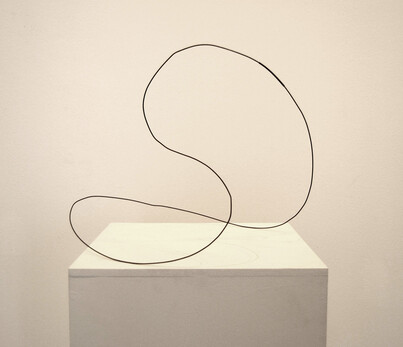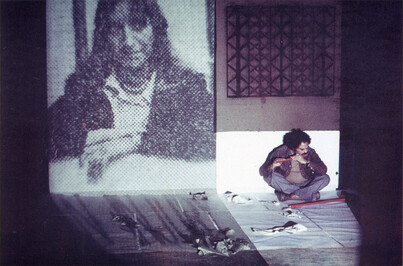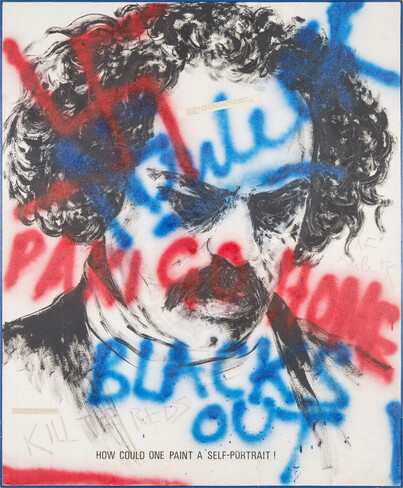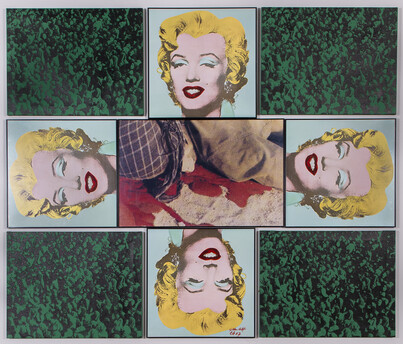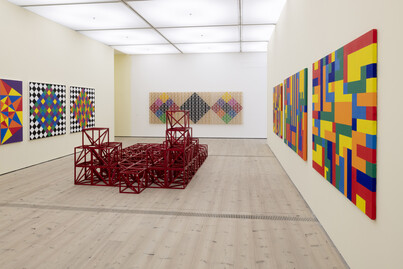Rasheed Araeen: Dancing between concept and form
by Hammad Nasar
Reviews /
Exhibition
• 15.01.2019
The expansive exhibition Rasheed Araeen: A Retrospective at the BALTIC, Gateshead, presents over fifty years of the artist’s wide-ranging practice arranged in six ‘chapters’. It begins with a carefully modulated account of his little-known Karachi years (1950–60s), from pencil portraits executed in Sunday sessions at the Artists’ Club to early experiments in painterly abstraction that reduce boats in the Karachi harbour to the essential triangle shapes. My First Sculpture (1959) FIG.1 – the swaying metal remainders of a bicycle wheel shaped by the fire of a burning rubbish heap – is in productive dialogue with dancing forms in paintings from the same period such as Aag ka Naach (Dance of Fire) (1961) and Ham Raqs (Dancers), (1959). Alongside a small selection of archival material that includes his designs for domestic windows and his parents’ house, these early works prefigure a life-long engagement in the dance between concept and form, between symmetry and movement.
The broadly chronological hang picks up Araeen’s artistic journey on his arrival in London in 1964. Sculpture No.1 (1965) FIG.2, a symmetrical arrangement of four painted I-beams on the floor, nods to the influence of Anthony Caro. Araeen, however, brings a restless energy to his experiments with sculptural form, moving swiftly from the use of industrial materials to humbler painted wood. He develops serial arrangements of open cube ‘structures’, with each face of the cube bisected by a diagonal strut. These modular forms invite constant reconfiguration – by the artist, but also with the active participation of viewers, who are encouraged to move the individual structures and hence reconfigure the overall form.
Araeen is often labelled a ‘British minimalist’, but this appellation is not an easy fit. His impulse to invite viewer participation shares a politics with the art of David Medalla as much as aesthetics with the work of Sol Lewitt or Donald Judd. Even Araeen’s exploration of symmetry, which has often been positioned as a reflection of his training as an engineer, can be interpreted as a visual commitment to democracy and equality.1 At a formal level, his lattice structures FIG.3 continue his engagement with triangular forms and vertical movement, evident in the undulating forms of his early Karachi paintings and the suspended oscillation of his bicycle wheel sculpture.2 The lattice works do however retain traces of the informal playfulness of his earlier work; a ludic impulse that Minimalism with a capital ‘M’ would struggle to accommodate.
Araeen has often spoken of the everyday racism he encountered in his dealings in Britain, particularly among its art establishment.3 When winning second place in Liverpool’s prestigious John Moores Painting Prize failed to generate institutional or gallery interest, it further fuelled Araeen’s disenchantment and marked a turn to political engagement. He joined the Black Panthers in 1972 and worked with Medalla in the group Artists for Democracy (1973–75). This political awakening manifested in Araeen a search for ‘a new language which would maintain my position as a modernist [. . .] and at the same time which would allow me to express my lived experience’.4
He turned to collage, photography, montage and performance. For Oluwale (1971–73/1975) FIG.4, a four-panel installation of newspaper clippings and photocopies pasted on board, addresses the death of Nigerian-born David Oluwale in Leeds in 1969 and its subsequent police investigation. The photographic grid When They Meet (1973) records a street confrontation between the National Front and anti-fascist protestors outside Conway Hall. Some of these images appear again in Araeen’s amalgam of performance, sound and slide projection, Paki Bastard (Portrait of the Artist as a Black Person) (1977/2016) FIG.5. Exploring issues of immigration, labour, racism and violence, the work still carries a political charge that is lent new meanings by contemporary ethno-nationalisms. It anticipates the tenor of practice now most associated with John Akomfrah and the Black Audio Film Collective and poses the question as to whether Gilbert & George had seen Araeen’s 1978 restaging of Paki Bastard at the Whitechapel Gallery, London, before or after they made their work Paki (1978).
From the mid-1970s Araeen also took up writing with his ‘Preliminary notes for a BLACK MANIFESTO’, a provocative call for ‘an art which embraces the radical consciousness of its time’ and a case study in the polemical potential of uppercase type.5 It was published simultaneously in Black Phoenix, a journal that Araeen started with the writer Mahmood Jamal, and Studio International. This was a strategic move which, as the art historian Courtney Martin points out in her insightful text in the sizeable catalogue accompanying the exhibition, allowed Araeen to ‘wrest control of his shifting public persona from an object maker to performer and writer’.6
In parallel, Araeen’s self-image becomes a central focus in his exploration of representation and visibility. In How Could One Paint a Self-Portrait FIG.6, racist graffiti obscures the artist’s pensive and downward gaze. In Ethnic Drawings (1982) different renditions of the same self-image are obscured by Urdu alphabets that spell nacho (dance), choomo (kiss) and chaato (lick), suggesting a performative subjugation.
It is not surprising that this most fecund period of artistic production strains the space available at the BALTIC, resulting in some work in the original exhibition at the Van Abbemuseum in Eindhoven being dropped. The most notable casualty is Christmas Day (1979), an arrangement of four photographs that capture the artist’s lonely reflection in the windows of an empty Circle Line train on Christmas Day in London. The work is an exploration of visibility, isolation, fitting in and place. It shares many of these concerns with his more celebrated works (How Could One Paint a Self-Portrait, or Ethnic Drawings) that sit in public collections, but does so with judicious economy of means and subtlety of form. Thanks to Araeen’s habit of recycling his existing work, the visitor to the BALTIC can still sample Christmas Day in Happy Christmas (1979–83), which deploys small versions of the Christmas Day photographs.
In the 1980s and 1990s Araeen combined arrangements of structures, lattice reliefs, monochrome painting and photomontage to bring together two seemingly divergent strands of his practice: investigations of geometry and abstraction, and his political interests. The Cruciform series of the mid-1980s brings the visual languages of popular advertising and mass media to a nine-panel minimalist grid format with a cross at its centre. In Golden Calf FIG.7 the central bloody image of a dead Iranian man is surrounded by Warhol’s screen prints of Marilyn Monroe in the four arms of the cross; in the corners are panels bearing a media image of mourning Iranian women. Araeen thus uses iconic form of both modernity and Christianity with image fragments of seemingly jarring incongruence. Two posthumous idols are locked in visual combat. The central image recalls sacrificial slaughter (as explored in Green Painting I, 1985–86) and is framed by the exemplary Pop image of female sexuality, itself surrounded by an anonymous and unknowable mass of shrouds. The work exemplifies Zöe Sutherland’s readings of the series as an interrogation of ‘the economic, military, and cultural hegemony of the West and its universalist pretensions’.7
The exhibition also stages a version of The Reading Room, 1979-2011 (2011), which was first made for the influential exhibition at the Zentrum für Kunst und Medien (ZKM), Karlsruhe, The Global Contemporary: Art Worlds After 1989 (2011-12). On top of an arrangement of Araeen’s structures is a selection of issues of Third Text, the influential journal he founded and edited from 1987–2011, which visitors are invited to read. This staging encourages readings of the parallels between the physical structures that shape our experience of the world, and linguistic and discursive structures (as embodied in the journal) that shape our perceptions of it. It underlines Araeen’s positioning of his work as a writer and editor as part of his artistic practice; more weaponry to arm his belief in art’s capacity to ‘confront neo-imperialism and offer a model of de-colonisation’.8 This is a position the exhibition supports with documentation of his influential exhibition The Other Story: Afro-Asian Artists in Post-War Britain (1989–90); his ongoing art-historical project, The Whole Story (begun 2001); and his more recent manifesto Art Beyond Art, Ecoaesthetics: A Manifesto for the 21st Century (2010) – conceptual projects and thought experiments that embody his conviction in art’s transformational capacity.
Homecoming – the final room in the exhibition FIG.8 – juxtaposes Araeen’s recent Opus paintings, which take the names of intellectuals from the Abbasid era (750-1258 AD), the so-called golden age of Islamic thought, as their point of departure, with two new lattice structures that reference Kazimir Malevich’s Black Square, 1913. The combination serves as a ‘claim for the role of Islamic art, in particular geometric abstraction, within the central trajectory of the history of modern art’.9 While the walls make claims about the past, the centre of the room suggests a hopeful future. Zero to Infinity (1968–2004/2017) invites visitors to play with its sixty-four cubes, the symmetrical and equal structures offering endless possibilities.
One can raise minor quibbles. The exhibition demands more space, and misses Araeen’s dramatic outdoor structures with scaffolding (more recently with bamboo) that would have been stunning in the BALTIC’s Tyne-side location. But what this long overdue retrospective exhibition, sensitively curated by Nick Aikens, accomplishes is to reveal the remarkable consistency and expansive range of Araeen’s practice. He surfs most waves. With his activism, editing, publishing, writing and curatorial work he emerges as a pivotal international figure in art’s move out of the confines of the gallery, and its reimagining as a site for contestation of histories, ideologies, and aesthetic and discursive regimes.
His time may finally have come. His installations were featured in both sites (Athens and Kassel) of the last Documenta; his structures greeted visitors at the last Venice Biennale (both 2017). But this international recognition is thanks in part to a much-admired exhibition at the Sharjah Art Foundation in 2014 and remains elusive at home. It is telling that this sizeable show and its accompanying publication were initiated by a Dutch museum. Araeen’s marginal presence in the well-rehearsed and exclusionist histories of art in Britain asks uncomfortable questions of the art histories being forged in the United Kingdom’s museums and universities.10
A small monitor at the end of the show plays an early interview with Araeen, where, in tracing the trajectory of his career, he registers his frustration at being excluded from the London mainstream. And while one is grateful to the BALTIC that audiences in the UK get to see this exhibition at all, it is a sad indictment of our national institutions that an artist of this range and international importance is still to receive a retrospective in the city he’s called home for six decades.




